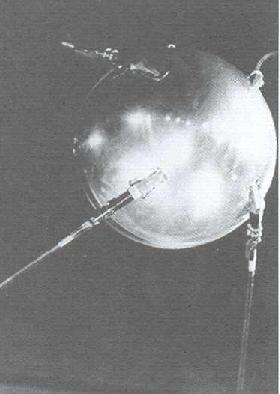Fifty Years of Trans-ionospheric Research
On 4 October 1957 the Soviet Union launched the world's first artificial satellite into an orbit that initially varied between 215 and 939 kilometres above the Earth's surface.

Sputnik-1 was a spherical satellite of 585 mm diameter and 83.6 kilogram in mass. From this sphere projected four whip-like antenna elements from 2.4 to 2.9 metres in length. These radiated radio signals on the two frequencies of 20.005 MHz and 40.002 MHz. These low frequencies were affected significantly in their passage through the ionosphere.
At the highest point in its orbit Sputnik-1 was well above the ionosphere, but at the lowest point or perigee, it travelled within the ionosphere, but below the peak plasma density. It was also operational during a time of very high sunspot activity when the ionospheric plasma was very dense.
The frequencies, on which it transmitted, together with its highly eccentric orbit, demonstrated a range of propagation effects through the ionosphere. Its signals were frequently heard when the satellite was well below the horizon of the receiving station. This was due to large ionospheric refraction and ducting. Several instances of antipodal reception were even reported.
For the first time, scientists were able to study man-made radio-wave propagation through the ionosphere rather than just bounce signals off the bottom side. This started a branch of radio science to explore trans-ionospheric radio propagation. Radio beacons were included on many subsequent satellites and transmitted on a wide range of frequencies from HF to microwave. Many conferences on satellite beacons were held in which these studies were reported and discussed.
Topside ionospheric sounders followed the early beacons. The first of these was the Canadian Alouette satellite which provided ionograms from above the ionosphere looking down toward the Earth. The Japanese ISIS satellite played a large role in exploring the topside of the ionosphere.
Although at this time it is difficult to find satellite beacons specifically designed for ionospheric research, scientists are now using the GPS constellation of navigation satellites to map the ionosphere using a technique called ionospheric tomography.
Trans-ionospheric effects include refraction, amplitude and phase scintillation, signal delay and polarisation rotation. These must be corrected for in many applications such as radio astronomy, space radar detection and ranging and navigation. Detailed knowledge of the ionosphere is vital to many technologies.
Material prepared by John Kennewell and Andrew McDonald.






